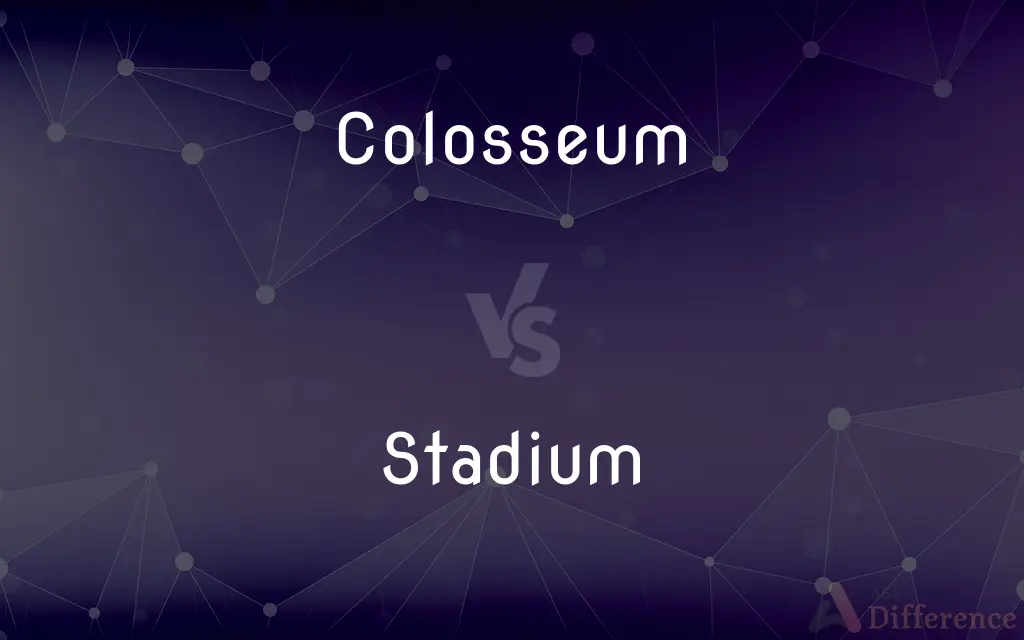Colosseum vs. Stadium — What's the Difference?
By Fiza Rafique & Urooj Arif — Updated on April 26, 2024
The Colosseum, an ancient Roman amphitheater, was specifically designed for gladiatorial contests and public spectacles, while modern stadiums are versatile venues primarily for sports and concerts.

Difference Between Colosseum and Stadium
Table of Contents
ADVERTISEMENT
Key Differences
The Colosseum, built in the first century AD, is an iconic symbol of ancient Rome, specifically designed for events like gladiatorial contests, mock sea battles, and dramas based on Classical mythology. Stadiums, on the other hand, are contemporary structures that accommodate a wide range of events including sports, concerts, and public gatherings.
Architecturally, the Colosseum features a complex system of vaults and arches typical of ancient Roman engineering, creating a freestanding structure made from stone and concrete. Modern stadiums vary in design but often use advanced materials like steel and reinforced concrete, and they incorporate technology for better viewability and comfort.
The seating capacity of the Colosseum was around 50,000 to 80,000, reflecting the societal importance of public spectacles in ancient Rome. Contemporary stadiums can often hold similar or greater numbers of spectators, but their designs emphasize ease of entry and exit, safety, and comfort, including amenities such as seats with backs and cupholders.
The Colosseum's historical significance lies in its age and its role in ancient Roman culture, making it a popular tourist destination. Stadiums, while culturally significant in terms of modern sports and entertainment, generally do not match the historical and architectural prestige of the Colosseum unless they too become historically significant over time.
In terms of functionality, the Colosseum had specific areas for different classes of spectators, which mirrored the rigid social hierarchy of Rome. Modern stadiums are designed with a more egalitarian approach, though premium options like box seats and VIP areas reflect contemporary social stratifications.
ADVERTISEMENT
Comparison Chart
Era
Ancient Roman (1st century AD)
Modern, contemporary
Primary Use
Gladiatorial contests, dramas
Sports, concerts, various events
Architectural Style
Ancient Roman with arches and vaults
Various, often modern with advanced materials
Seating Capacity
Approx. 50,000 to 80,000
Can vary, often similar or larger
Cultural Significance
Historical monument
Venue for modern entertainment and sports
Compare with Definitions
Colosseum
A large theatre or arena in Rome, anciently used for public spectacles, especially gladiatorial games.
The Colosseum in Rome could hold tens of thousands of spectators in its heyday.
Stadium
A sports arena with tiers of seats for spectators.
The new stadium can seat over 100,000 fans, making it one of the largest in the nation.
Colosseum
Symbolic of ancient Roman engineering prowess and social customs.
Tourists visit the Colosseum to marvel at the ancient architecture and to imagine the historical events that took place there.
Stadium
Utilized for a variety of events including sports, concerts, and large gatherings.
Last month, the stadium hosted a major rock concert and three football games.
Colosseum
Classified as an elliptical amphitheater.
The Colosseum's design as an elliptical amphitheater was revolutionary at the time of its construction.
Stadium
Often part of modern urban development plans.
The stadium was designed to be easily accessible by public transportation to reduce traffic on game days.
Colosseum
Represents the imperial power of Rome.
The Colosseum was a display of Roman imperial strength and a tool for public entertainment.
Stadium
Can be open or covered, depending on design and location.
The stadium features a retractable roof to accommodate different weather conditions.
Colosseum
Listed as a World Heritage Site.
The Colosseum is a UNESCO World Heritage Site, attracting millions of visitors annually.
Stadium
Includes modern amenities for comfort and safety.
Every seat in the stadium is equipped with a cup holder and easy access to exits.
Colosseum
The Colosseum ( KOL-ə-SEE-əm; Italian: Colosseo [kolosˈsɛːo]) is an oval amphitheatre in the centre of the city of Rome, Italy, just east of the Roman Forum. It is the largest ancient amphitheatre ever built, and is still the largest standing amphitheatre in the world today, despite its age.
Stadium
A stadium (plural stadiums or stadia) is a place or venue for (mostly) outdoor sports, concerts, or other events and consists of a field or stage either partly or completely surrounded by a tiered structure designed to allow spectators to stand or sit and view the event.Pausanias noted that for about half a century the only event at the ancient Greek Olympic festival was the race that comprised one length of the stadion at Olympia, where the word "stadium" originated.Most of the stadiums with a capacity of at least 10,000 are used for association football. Other popular stadium sports include gridiron football, baseball, cricket, the various codes of rugby, field lacrosse, bandy, and bullfighting.
Colosseum
The name since medieval times of the Amphitheatrum Flavium, a vast amphitheatre in Rome, begun c.75 AD.
Stadium
A large, usually open structure for sports events with tiered seating for spectators.
Colosseum
Variant of coliseum.
Stadium
A course on which foot races were held in ancient Greece, usually semicircular and having tiers of seats for spectators.
Colosseum
Alternative spelling of coliseum
Stadium
An ancient Greek measure of distance, based on the length of such a course and equal to about 185 meters (607 feet).
Colosseum
The amphitheater of Vespasian in Rome.
Stadium
(Medicine) A stage or period in the course of a disease.
Colosseum
Amphitheater in Rome built about AD 75 or 80
Stadium
(Biology) A stage in the development or life history of an organism.
Stadium
A venue where sporting events are held.
Stadium
An Ancient Greek racecourse, especially, the Olympic course for foot races.
Stadium
(historical) stadion, a Greek unit of length equivalent to about 185 m.
Stadium
A kind of telemeter for measuring the distance of an object of known dimensions, by observing the angle it subtends.
Stadium
(surveying) a graduated rod used to measure the distance of the place where it stands from an instrument having a telescope, by observing the number of the graduations of the rod that are seen between certain parallel wires (stadia wires) in the field of view of the telescope.
Stadium
(biology) A life stage of an organism.
Stadium
A Greek measure of length, being the chief one used for itinerary distances, also adopted by the Romans for nautical and astronomical measurements. It was equal to 600 Greek or 625 Roman feet, or 125 Roman paces, or to 606 feet 9 inches English. This was also called the Olympic stadium, as being the exact length of the foot-race course at Olympia.
Stadium
A race course; especially, the Olympic course for foot races.
Stadium
A modern structure, with its inclosure, resembling the ancient stadium{2}, used for athletic games which are typically played out-of-doors; such stadiums are usually large structures without roofs, though some modern stadiums may have a protective dome overhead. It may be contrasted with the arena, the term commonly used for smaller structures at which indoor games are played.
Stadium
A kind of telemeter for measuring the distance of an object of known dimensions, by observing the angle it subtends; especially (Surveying), a graduated rod used to measure the distance of the place where it stands from an instrument having a telescope, by observing the number of the graduations of the rod that are seen between certain parallel wires (stadia wires) in the field of view of the telescope; - also called stadia, and stadia rod.
Stadium
A large structure for open-air sports or entertainments
Common Curiosities
How do modern stadiums differ from the Colosseum in terms of usage?
Modern stadiums are versatile venues used for a variety of events including sports, concerts, and public gatherings.
What was the primary purpose of the Colosseum?
The Colosseum was primarily used for gladiatorial contests and public spectacles.
What are some architectural features of the Colosseum?
The Colosseum features a complex system of vaults and arches, with an elliptical structure made from stone and concrete.
What role does technology play in modern stadiums compared to the Colosseum?
Modern stadiums incorporate advanced technology for scoreboards, lighting, sound systems, and sometimes retractable roofs, which were not present in the Colosseum.
How do the materials used in the construction of modern stadiums compare to those used in the Colosseum?
Modern stadiums often utilize advanced materials like steel, reinforced concrete, and high-tech polymers, which contrast with the stone and concrete used in the Colosseum.
How do safety standards at modern stadiums compare to those at the Colosseum?
Modern stadiums are designed with strict safety standards in mind, including emergency exits, crowd control measures, and structural safety, which greatly surpass the safety considerations of the Colosseum.
What is the historical significance of the Colosseum compared to a modern stadium?
The Colosseum holds significant historical value as a symbol of ancient Roman life and architecture, whereas modern stadiums are more reflective of contemporary culture and technological advancements.
Can stadiums hold more spectators than the Colosseum?
Some modern stadiums can hold more spectators than the Colosseum due to advances in design and safety regulations, with capacities exceeding 100,000.
Are there any similarities between the Colosseum and modern stadiums?
Both the Colosseum and modern stadiums serve as major cultural centers for entertainment and social gatherings, although the types of events they host can differ.
How has the purpose of these structures evolved over time?
While the Colosseum was primarily used for gladiatorial contests and public spectacles, modern stadiums have evolved to accommodate a broader range of events including sports, music concerts, and community events.
What future developments are expected in stadium architecture?
Future developments in stadium architecture are expected to include more sustainable materials, smart technology integration for enhancing fan experience, and designs that can adapt to multiple types of events.
How is the viewer's experience different in a stadium compared to the Colosseum?
The viewer's experience in modern stadiums is enhanced by comfortable seating, better sightlines, and amenities like food services and restrooms, which differ significantly from the harsh conditions of the Colosseum.
Share Your Discovery

Previous Comparison
Hum vs. Buzz
Next Comparison
Inductance vs. CapacitanceAuthor Spotlight
Written by
Fiza RafiqueFiza Rafique is a skilled content writer at AskDifference.com, where she meticulously refines and enhances written pieces. Drawing from her vast editorial expertise, Fiza ensures clarity, accuracy, and precision in every article. Passionate about language, she continually seeks to elevate the quality of content for readers worldwide.
Co-written by
Urooj ArifUrooj is a skilled content writer at Ask Difference, known for her exceptional ability to simplify complex topics into engaging and informative content. With a passion for research and a flair for clear, concise writing, she consistently delivers articles that resonate with our diverse audience.














































